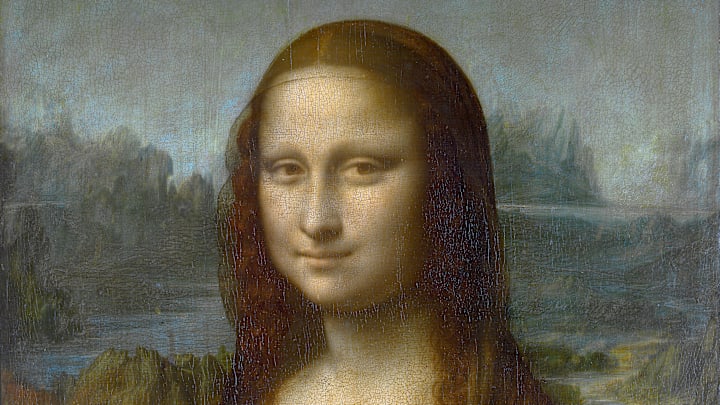The Mona Lisa, painted by Leonardo da Vinci in the early 16th century, has often been described as the most famous painting in the world. But despite all we do know about this work of art, there are still a number of lingering questions. Here is a look at five unresolved mysteries surrounding the Mona Lisa.
1. What title (if any) did Leonardo da Vinci actually give the painting?
The fame of the title Mona Lisa obscures an important fact: There is no evidence whatsoever of Leonardo himself using it. The writings of the art historian Giorgio Vasari contain one of the earliest accounts of the work. He discussed it in his biography of Leonardo in Lives of the Most Eminent Italian Architects, Painters, and Sculptors, more commonly known as Lives of the Artists (1550): “Leonardo undertook to execute, for Francesco del Giocondo, the portrait of Mona Lisa, his wife.” Vasari’s account is the first known use of the now-famous name, and he does not claim the work actually had this title, merely using it to describe the work in general (“the portrait of Mona Lisa, his wife”).
The Mona element of the title is also a misspelling of Monna, an Italian term used at the time to denote a woman of high status (a contraction of the term mia donna, or “my lady” in English). Leonardo makes no direct mention of the painting in his own notes, so it remains unknown what title (if any) he would have given it himself.
2. Where is the landscape in the background of the Mona Lisa?

The subject of the Mona Lisa sits in front of a landscape featuring trees, pathways. and distant hilltops. What is not clear is the identity of this location. There has even been speculation that the background was imaginary and not intended to replicate a real place. However, a number of arguments have also been made for places that do exist: One is the town of Bobbio in the north of Italy, which has a bridge similar to one in the background of the Mona Lisa, while others have suggested the valley of the River Arno in Tuscany.
3. Why did Giorgio Vasari describe the Mona Lisa as unfinished?
Another mystery surrounding the painting stems from the difference between Vasari’s description in Lives of the Artists and the work as it appears to us today. One particular oddity is that the art historian describes Leonardo as not having completed the painting: “After toiling over it for four years, he left it unfinished.” Yet the painting in the Louvre does not seem to be noticeably incomplete, with much detail devoted to the features of the landscape as well as to the image of the woman herself. One possibility is that any unfinished elements were completed at a later date by others, hence its current appearance. However, it seems unlikely that the court of the king of France—who obtained the painting—would interfere with a work from a revered artist.
4. Why does the Mona Lisa only show the edges of columns on either side?

One of the most unusual features of the painting is that it features the edge of column bases on both sides, but does not show the whole columns themselves. For many years, this led people to conclude that the painting had been cropped and some of the material lost (as has been the case with some other famous paintings like Rembrandt’s The Night Watch, which was cropped in the 18th century to make it easier to exhibit at a museum).
In the early 1990s, art professor Frank Zöllner examined the Mona Lisa without its frame and concluded that it had not been trimmed [PDF]. Leonardo painted the portrait on wood, not canvas, which made it easier to tell the original material had not been modified once the frame was removed. The question of why he must have opted to only show the edge of the columns, rather than make a clear choice to include or exclude them, remains unanswered.
5. Did Leonardo da Vinci create more than one version of the Mona Lisa?
One of the most widespread theories about the Mona Lisa is that Leonardo may have painted more than one version of it. The painting is also known by its Italian name, La Gioconda (Italian for The Smiling One). The artist Giovanni Paolo Lomazzo, writing in the late 16th century, once declared that “the two most beautiful and important portraits by Leonardo are the Mona Lisa and the Gioconda.” This suggests that during this period, they were regarded as two different paintings, rather than alternate names for the same work.
The possibility of a different version of the portrait is also endorsed by a famous sketch Raphael made during a visit to Leonardo’s studio. It differs in some respects from the Louvre painting, and clearly shows two whole columns in the background.
After his examination of the intact nature of the Louvre painting in the ‘90s, Zöllner concluded it was possible Leonardo had created a second version of the work that had shown the whole columns [PDF]. A number of other paintings have been suggested as this second Gioconda, the most well-known being the “Isleworth Mona Lisa,” but none have been conclusively established to date.
